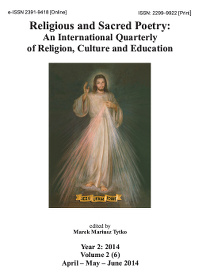Biblical Quotations in Latvian Cemetery Epitaphs
Biblical Quotations in Latvian Cemetery Epitaphs
Author(s): Rita TreijaPublished by: Fundacja Naukowa Katolików »Eschaton«
Keywords: Latvian cemeteries; epitaphs; biblical quotations; religious poetry; intertextuality
Summary/Abstract: The article is part of a wider study on Latvian cemetery epitaphs which is being carried out by Rita Treija at the Institute of Literature, Folklore and Art, University of Latvia. The source of the study is a wide material of the Latvian tombstone inscriptions covering the time period from the 19th to the 21st century. The bulk of materials obtained comes from the Archives of Latvian Folklore as well as the author’s private collection. The author seeks to analyse the multilayered nature of the memorial inscriptions on gravestones both from a philologist’s and folklorist’s perspective, focusing mainly on the use of biblical quotations and allusions in the epitaph textual tradition. The textual analysis of Latvian cemetery epitaphs shows that the Bible is an important source of reference used both directly and indirectly in the composition of the memorial texts for the deceased. There are four levels that can be distinguished according to the distance from the original source: (1) direct biblical quotations (with or without references to particular verses of the Scripture); (2) liturgical prayers (excerpted from the ordinary procedure of the public worship, as well as from special funeral and memorial rituals); (3) church songs (quoted from the Roman Catholic or Evangelical Lutheran hymnals); (4) usage of biblical characters and motives in other texts (such as individual prayers, religious poetry, etc.). The presence of biblical quotations and allusions in the epitaphs provides a certain repertoire of gravestone texts. However, besides the manifestations of the religious identity, the material of the Latvian memorial inscriptions shows that there are other approaches in creating epitaph texts, such as quoting Latvian folksongs, mourning lyrics, popular songs, etc. The results of the analysis can be applied in comparative epitaph studies as a Latvian example. The issues discussed in the article may be useful in cultural and folk religion studies, too.
Journal: Religious and Sacred Poetry: An International Quarterly of Religion, Culture and Education
- Issue Year: 2014
- Issue No: 2
- Page Range: 187-204
- Page Count: 18

